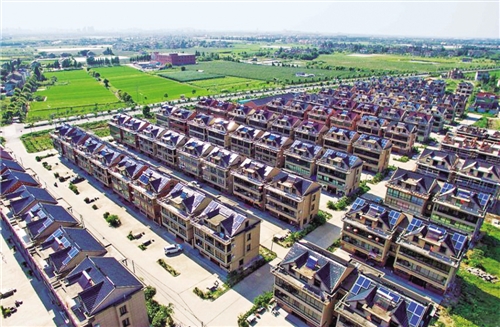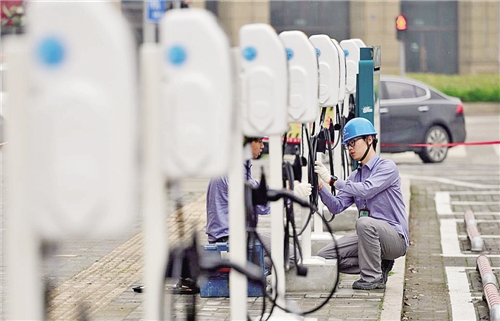
Recently, the National Energy Administration (NEA) announced the first batch of 55 "Internet+" Smart Energy (Energy Internet) demonstration projects. This includes 12 urban energy internet integrated demonstration projects, such as the Beijing Yanqing Energy Internet Integrated Demonstration Zone and the Chongming Energy Internet Integrated Demonstration Project. These projects are mandated to commence by the end of August 2017 and be completed by the end of 2018. This signifies that an era of urban development characterized by clean and efficient energy utilization is on the horizon.

Pictured is the newly constructed photovoltaic village, Pengdun Village in Haining, Zhejiang Province, which is already taking shape. Photo by Wang Yichen.

Haining is accelerating the construction of charging piles to promote green travel. Pictured are staff members inspecting charging piles. Photo by Wang Yichen.
Simply put, the urban energy internet is an electricity-centric platform for the interconnection, comprehensive utilization, and optimized sharing of various urban energy sources. The construction of an urban energy internet is based on smart grids, uses "Internet+" as a tool, and takes electric power as its main carrier, forming a green, low-carbon, safe, and efficient modern energy ecosystem.
"China has become the world's largest energy consumer, but its currently proven energy reserves are very limited. With the acceleration of urbanization and industrialization across various regions, the energy demand gap will further widen. Furthermore, the inverse distribution of China's energy-rich regions and its load centers leads to an inefficient match between energy supply and demand, making the outlook for sustainable development concerning. In addition, haze has become a prominent symbol of air pollution in China in recent years," stated Chu Yanfang, Deputy General Manager of State Grid Sichuan Electric Power Company. She added that "efforts to improve the carrying capacity and operational efficiency of energy infrastructure across the country, accelerating the shift in urban energy consumption habits, achieving clean energy substitution and integrated optimal allocation of energy, and constructing urban energy internet are imperative."
Building urban energy internet is also a necessity for safeguarding China's economic and social development. Taking Chengdu as an example, it is estimated that by the end of the "13th Five-Year Plan" period, the city's total electricity consumption will reach 65.8 billion kWh, with an average annual growth rate of 6.20%. "Due to limited natural resources, Chengdu itself has scarce resources. Therefore, it is essential to establish the urban energy internet as a foundation to facilitate large-scale energy transmission, optimize energy allocation across all districts and counties of Chengdu, and ensure the city's power supply needs," said Chu Yanfang.
Zhu Xin, a technician from State Grid Zhejiang Haining Power Supply Company, stated that residential photovoltaic power generation is subject to limitations such as weather and technology, leading to issues like unstable electricity output. Energy storage stations store the surplus electricity generated by residential photovoltaics for use when needed, while also improving power quality. In addition to low-carbon energy, Haining also plans to advance the construction of its urban energy internet in multiple aspects, including efficient power grids, green transportation, low-carbon buildings, and energy big data sharing platforms.
In the Sichuan Tianfu New Area Energy Internet Demonstration Project, "smart terminal synchronous measurement" has become a key technology to tackle. "Improving energy efficiency is a crucial goal in building the energy internet. Whether China can achieve sustained economic growth with less energy consumption largely depends on whether the potential for energy efficiency improvement can be effectively unlocked," said a project manager. They added that the key to improving energy efficiency lies with the users. How to help them formulate reasonable smart energy consumption plans, carry out targeted energy efficiency upgrades, and enable users to improve energy efficiency without affecting their normal production and life, has become an urgent problem to be solved.
Grid security is the primary challenge we face. As for the current large power grids, their safety and reliability can generally meet user requirements. If urban rooftop photovoltaics are extensively developed and directly connected to the main grid, their safety and reliability will be significantly reduced, and the system's power quality will deteriorate, leading to serious impacts on users, especially precision users. In certain special circumstances, it could also pose a challenge to system stability. Li Fengling stated that with the backup support of the main grid, microgrids should achieve autonomy and self-healing as much as possible, minimizing the probability of affecting system security.
The advancement of urban energy internet is inseparable from reasonable and effective business models. In Li Fengling's view, the biggest problem in implementing energy internet projects is market barriers. "Integrating distribution grid operation with energy sales, and combining investment with operation, is the most effective and feasible model among various approaches. However, because it involves distribution networks and power sales based on these networks, it touches upon existing interest structures. Even incremental markets may be regarded as anticipated profits by power grid companies. If power grid companies do not cooperate, social capital will find it very difficult to proceed. Therefore, strong government promotion of pilot and demonstration projects is crucial," Li Fengling said.
In response, Chu Yanfang suggested actively promoting cross-industry and cross-domain cooperation in energy to collectively address issues related to policy, market, technology, and funding concerning urban energy internet. From the perspective of sustainable urban energy development, building an urban energy internet can drive national economic transformation and energy transition, strengthen infrastructure construction, make the economic layout more balanced and coordinated, and achieve comprehensive mutual benefit and win-win outcomes.